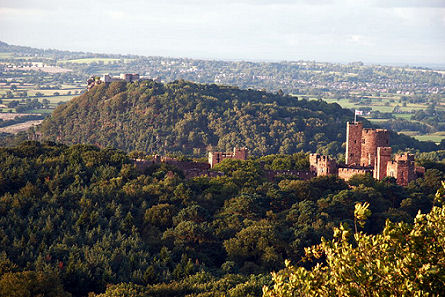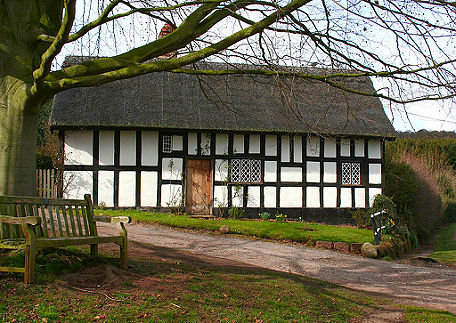Peckforton
OS Grid ref:- SJ538564
 The scattered village of Peckforton is situated around 6 miles from the town of Malpas.
The scattered village of Peckforton is situated around 6 miles from the town of Malpas.
The scenic Peckforton Hills consist of a triassic, sandstone ridge running northeast-southwest across the Cheshire Plain. They form a significant part of the longer Mid Cheshire Ridge. Rugged sandstone outcrops, lofty trees and panoramic views both east and west across a patchwork landscape. The high points are Peckforton Point (SJ529557; 203 m), immediately north of Bulkeley Hill, and Stanner Nab (SJ531573; 200 m), towards the northern end of the ridge.
There is evidence of settlement on the hills dating from the neolithic or Bronze Age. A 57.88 hectares area of Peckforton Woods has been designated a Site of Special Scientific Interest. The Peckforton Hills were quarried during the Roman era and the village itself is recoreded in the Domesday Book of 1086, when it was held by one Wulfric.
Peckforton and the neighbouring village of Beeston formed part of an estate which was purchased by John Tollemache, 1st Baron Tollemache (1805-1890) in 1840. An M.P. and High Sheriff of Cheshire, Lord Tollemache built Peckforton Castle, a Victorian sandstone castle, designed in the medieval style, in 1844-50. It boasts a gatehouse, a portcullis, a dry moat, external windows shaped as arrow slots, and large towers and was designed by the architect Anthony Salvin.The Tollemache family continued to live in the castle until 1939. The Castle now operates as a luxury hotel specialising in weddings, conferences and leisure breaks.
 In a garden in Stone House Lane in the village is a curious red sandstone carving which shows an elephant bearing a castle. The carving is the work of John or William Watson, a stonemason who worked on Peckforton Castle and dates from around 1859. The meaning of the carving is not known. The elephant and castle device formed part of the crest of the Worshipful Company of Cutlers and is often associated with public houses, but there has never been a pub called The Elephant and the Castle in Peckforton. An elephant also appears in the arms of the Corbett family, local landowners before 1626.
In a garden in Stone House Lane in the village is a curious red sandstone carving which shows an elephant bearing a castle. The carving is the work of John or William Watson, a stonemason who worked on Peckforton Castle and dates from around 1859. The meaning of the carving is not known. The elephant and castle device formed part of the crest of the Worshipful Company of Cutlers and is often associated with public houses, but there has never been a pub called The Elephant and the Castle in Peckforton. An elephant also appears in the arms of the Corbett family, local landowners before 1626.
Some of the oldest buildings in the village are Manor Farm Cottage and Yew Tree Cottage, which both date back to the early seventeenth century. The black and white thatched cottage which stands on Stone House Lane was built in the late seventeenth century.
Smithy Cottage, also dating from the seventeenth century, is a timber-framed cottage infilled with a mixture of brick and sandstone. Peckforton Hall, a farmhouse dating to the late seventeenth century, is situated just to the east of the village (grid ref- SJ545565).
The Sandstone Trail long distance footpath passes the village.
Nearby places of interest
Beeston Castle a dramatic sandstone castle, perched on a hill, dating back to 1225 and founded by Ranulf, the sixth Earl of Chester.
Cheshire Workshops a visitor attraction providing fun and entertainment for all ages set in the picturesque village of Burwardsley. Candle making has been a craft at Burwardsley for over fifty years when these unique hand carved candles were first made. Ancient candle making skills are still practiced at the workshop.
Bunbury Locks, a working wharf with staircase locks is situated around a mile north of the village. The locks were once an important stopping place on the Chester Canal, which was constructed in in the 1770's to link Chester and Nantwich. The canal warehouse stands beside the locks. Canal Cruisers were once built in the long building beside the locks.
